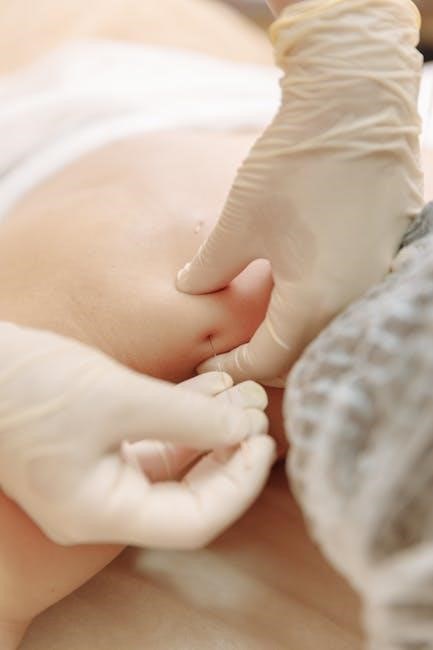Acupuncture points are specific locations on the body used in traditional Chinese medicine to treat various diseases. These points enhance self-regulatory capabilities, aiding in homeostasis and disease prevention.
What Are Acupuncture Points?
Acupuncture points are specific anatomical locations on the body used in traditional Chinese medicine (TCM) to stimulate therapeutic effects. These points are believed to lie along meridians, or energy pathways, through which qi (life energy) flows. When stimulated, such as with needles or pressure, they enhance the body’s self-regulatory capabilities, aiding in homeostasis and disease prevention. Research indicates these points are associated with multireceptive fields of neurons, suggesting a scientific basis for their effects. There are various types of acupuncture points, each with distinct actions, such as pain relief or internal organ regulation, making them versatile for treating diverse health conditions.

Origin and History of Acupuncture in Traditional Chinese Medicine (TCM)
Acupuncture, a cornerstone of traditional Chinese medicine (TCM), has a rich history dating back thousands of years. Its origins trace to ancient China, where it evolved as a therapeutic practice to restore balance and harmony in the body. The philosophy of qi (life energy) and meridians (energy pathways) underpins its development. Early texts like the “Huangdi Neijing” (Yellow Emperor’s Inner Canon) detailed acupuncture techniques and point locations. Over centuries, acupuncture refined into a sophisticated system, incorporating precise point locations and stimulation methods. Initially used for pain relief and internal disorders, its applications expanded to address a wide range of health conditions, becoming a global therapeutic practice.
Importance of Acupuncture Points in Modern Medicine
Acupuncture points play a vital role in modern medicine, offering a non-invasive approach to treating various diseases. Their stimulation enhances the body’s self-regulatory capabilities, aiding in homeostasis and disease prevention. Modern research highlights their effectiveness in managing chronic conditions like diabetes, obesity, and mental health disorders. Acupuncture points are increasingly integrated into contemporary healthcare, providing complementary therapies for pain relief, anxiety, and neurological conditions such as Parkinson’s and multiple sclerosis. Their application in weight loss and gout further underscores their versatility. By addressing both physical and mental health, acupuncture points have become a valuable tool in holistic and integrative medicine, bridging traditional practices with modern therapeutic needs.
The Science Behind Acupuncture Points
Acupuncture points interact with multireceptive neural fields, enhancing the body’s self-regulatory and modulatory capabilities to maintain homeostasis, scientifically supporting their role in preventing and treating various diseases.

Relationship Between Acupuncture Points and Multireceptive Fields of Neurons
Acupuncture points are closely linked to multireceptive fields of neurons, which are areas of the nervous system capable of detecting various stimuli. When these points are stimulated, they activate neural pathways, influencing pain perception, inflammation, and organ function. This interaction enhances the body’s ability to regulate internal processes, contributing to homeostasis. Studies suggest that the stimulation of acupuncture points can modulate neural activity, offering therapeutic benefits for conditions like chronic pain and neurological disorders. The connection between acupuncture points and neural fields provides a scientific basis for understanding their role in treating various diseases and improving overall health outcomes.
How Acupuncture Enhances the Body’s Self-Regulatory Capabilities
Acupuncture enhances the body’s self-regulatory capabilities by stimulating neural pathways and modulating various physiological systems. It influences the nervous system, endocrine system, and immune response, promoting balance and recovery. By activating specific points, acupuncture improves the body’s ability to regulate pain, inflammation, and organ function. This modulation supports homeostasis, enabling the body to recover from various conditions. The practice also enhances the body’s adaptive responses, helping it cope with stress and maintain internal stability. Through these mechanisms, acupuncture serves as a holistic approach to restoring and maintaining health, addressing both physical and mental well-being effectively.
Role of Acupuncture in Maintaining or Restoring Homeostasis
Acupuncture plays a significant role in maintaining or restoring homeostasis by regulating the body’s internal balance. It achieves this by influencing the nervous and endocrine systems, which control various physiological processes. Through stimulation of specific points, acupuncture modulates the body’s response to stress, pain, and inflammation, promoting equilibrium. This practice helps restore normal organ function and metabolic activity, addressing disruptions caused by disease or environmental factors. By enhancing the body’s self-regulatory mechanisms, acupuncture supports overall health and well-being, making it a valuable approach for preventing and managing a wide range of conditions.
Acupuncture Points and Their Characteristics
Acupuncture points are specific body locations with unique effects, influencing various physiological functions. They are used to treat and prevent diseases by stimulating the body’s natural healing processes.
Effect of Acupuncture Points on the Body
Acupuncture points stimulate specific physiological responses, enhancing the body’s self-regulatory and modulatory functions. By influencing multireceptive neuron fields, they regulate pain, inflammation, and organ systems. Regular use can restore homeostasis, improving overall health and preventing diseases. These points also boost immune function and emotional well-being, offering holistic benefits for various conditions, from chronic pain to mental health disorders. Their effects are tailored to individual needs, making them versatile in addressing diverse health challenges effectively.
Types of Acupuncture Points and Their Special Actions
Acupuncture points are categorized into various types, each with distinct functions. Back-Shu points target internal organs, while Front-Mu points regulate Qi and blood flow. Five-Shu points influence specific meridian energies, addressing conditions like pain and inflammation. Extraordinary points, such as those on the ears or scalp, treat mental and emotional disorders. Each type has unique actions, enabling practitioners to tailor treatments for diverse health issues. These points are strategically used to restore balance, enhance healing, and improve overall well-being, making them versatile tools in addressing various diseases and promoting holistic health.
Measuring System for Acupuncture Points
The measurement of acupuncture points is based on anatomical landmarks and proportional distances. The traditional unit, “cun,” is used, where one cun equals the width of the patient’s thumb. Points are located using specific techniques, such as palpation and measurement along meridians. Modern tools, like acupuncture charts and digital devices, aid in precise location. This system ensures consistency and accuracy in identifying points for various therapeutic applications, making it a cornerstone of effective acupuncture practice.

Acupuncture Points for Specific Diseases
Acupuncture points offer targeted treatments for various conditions, including diabetes, weight loss, anxiety, Parkinson’s, MS, and gout, improving symptoms and enhancing quality of life.
Acupuncture Points for Diabetes Management
Acupuncture points for diabetes management target specific areas to regulate blood sugar levels and improve insulin sensitivity. Key points include Zusanli (ST36) and Yishui (SP16), located on the leg and abdomen. These points enhance pancreatic function and glucose metabolism. Regular acupuncture sessions can reduce blood sugar fluctuations and alleviate symptoms like fatigue and neuropathy. Combining acupuncture with lifestyle changes and medication offers a holistic approach to diabetes care. Research suggests acupuncture may improve glycemic control and quality of life for diabetic patients, making it a valuable complementary therapy in diabetes management.
Acupuncture Points for Weight Loss and Obesity
Acupuncture points for weight loss and obesity target areas that regulate appetite, metabolism, and fat storage. Key points include Zusanli (ST36) and Tianshu (ST25), located on the leg and abdomen. These points stimulate digestion and fat metabolism, helping reduce body weight. Acupuncture enhances satiety hormones, curbing overeating and cravings. Regular sessions improve insulin sensitivity and boost energy expenditure. While acupuncture supports weight loss, it is most effective when combined with a healthy diet and exercise. Studies suggest acupuncture may aid in sustainable weight management, making it a complementary therapy for obesity and related metabolic disorders.
Acupuncture Points for Anxiety and Mental Health
Acupuncture points for anxiety and mental health target areas that calm the mind and regulate emotional responses. Key points include Yintang (Third Eye Point), Shenmen (Heart 7), and Sanyinjiao (Spleen 6). Yintang, located between the eyebrows, helps reduce stress and anxiety by balancing the nervous system. Shenmen, found on the wrist, is known for its calming effects and is often used to treat insomnia and emotional distress. Sanyinjiao, located on the lower leg, supports mental clarity and emotional stability. Acupuncture stimulates the release of neurotransmitters like serotonin, which improves mood and reduces anxiety. Regular sessions can provide long-term relief, making it a valuable complementary therapy for mental health conditions.

Acupuncture Points for Parkinson’s Disease and Gait Function
Acupuncture has shown promise in improving gait function and managing symptoms of Parkinson’s disease. Key points like GB34 (Yanglingquan) and LI4 (Hegu) are often used to enhance motor function and balance. GB34, located on the leg, is known for its role in muscle relaxation and joint mobility, which can help improve gait. LI4, found on the hand, is believed to stimulate nerve pathways that support movement coordination. Studies suggest that acupuncture can improve gait function in Parkinson’s patients by enhancing dopamine levels and reducing rigidity. Regular sessions may also reduce tremors and improve overall quality of life, making it a valuable complementary therapy for managing Parkinson’s symptoms.

Acupuncture Points for Multiple Sclerosis Symptoms

Acupuncture may alleviate symptoms of multiple sclerosis (MS) by targeting specific points that address pain, fatigue, and spasticity. Points like LI4 (Hegu) and ST36 (Zusanli) are commonly used to improve energy levels and reduce muscle stiffness. LI4, located on the hand, helps relieve pain and inflammation, while ST36, on the leg, enhances overall vitality and digestion. Some studies suggest acupuncture can improve mobility and reduce fatigue in MS patients by stimulating nerve pathways and promoting relaxation. While research is ongoing, acupuncture is increasingly recognized as a complementary therapy to manage MS symptoms and improve quality of life for those affected.
Acupuncture Points for Gout and Rheumatic Diseases
Acupuncture offers relief for gout and rheumatic diseases by targeting specific points that reduce pain and inflammation. Points like GB34 (Yanglingquan) and SP9 (Yinlingquan) are commonly used to address joint pain and swelling. GB34, located on the leg, helps alleviate pain and stiffness, while SP9 supports the spleen and kidney functions, reducing inflammation. Regular acupuncture treatment can improve joint mobility and reduce uric acid levels, which are often elevated in gout. Swami Ramdev recommends daily acupressure to relieve rheumatic diseases. While not a cure, acupuncture is a complementary therapy that can manage symptoms and improve quality of life for those with gout and rheumatic conditions.

Meridian Theory and Acupuncture Points
Meridian theory guides acupuncture by mapping energy pathways through the body. A simple flow chart helps select acupoints effectively, enhancing treatment outcomes for various conditions.
Simple Acupoints Prescription Flow Chart Based on Meridian Theory
A simple acupoints prescription flow chart, developed based on meridian theory, aids clinicians in selecting acupoints effectively. This chart, studied in 102 dogs, demonstrated its usefulness in guiding acupoint selection, improving treatment outcomes. By following the flow chart, practitioners can systematically identify appropriate points for various conditions, ensuring a more standardized and efficient approach. This tool aligns with meridian theory, which maps energy pathways through the body, enhancing the accuracy of acupuncture treatments. The chart’s effectiveness highlights its potential as a practical resource for both humans and animals, simplifying the complex process of acupoint selection.

How Meridian Theory Guides Acupuncture Practice
Meridian theory, a cornerstone of traditional Chinese medicine, maps the flow of Qi (vital energy) through the body via interconnected pathways. These meridians link organs and tissues, guiding acupuncture practice by identifying points that restore balance. Practitioners use meridian theory to diagnose and treat diseases by targeting specific points along these pathways. This approach ensures treatments address the root cause, promoting holistic healing. By understanding meridian connections, acupuncture effectively enhances Qi flow, balancing Yin and Yang energies. This ancient framework remains essential for modern acupuncture, offering a structured method to maintain health and treat various conditions effectively.

Safety and Effectiveness of Acupuncture
Acupuncture is proven effective for various diseases, supported by research. Safety is ensured with proper needle techniques and professional guidance, minimizing risks and optimizing therapeutic benefits.
Research on the Effectiveness of Acupuncture for Various Diseases
Research highlights acupuncture’s effectiveness in treating diverse conditions, including anxiety, Parkinson’s disease, and multiple sclerosis. Studies demonstrate its ability to enhance self-regulatory functions and maintain homeostasis, reducing symptoms and improving quality of life. Clinical trials show significant benefits for gout and rheumatic diseases, with acupuncture providing relief from pain and inflammation. Its role in diabetes management and weight loss is also supported by evidence, offering a complementary approach to conventional treatments; Overall, acupuncture’s therapeutic potential is well-documented, making it a valuable option for addressing a wide range of health issues.
Safety Considerations When Using Acupuncture Points
Acupuncture is generally safe when performed by a licensed practitioner using sterile needles. Common side effects include minor pain, bruising, or dizziness. Rare complications, such as infections or nerve damage, can occur if proper hygiene and technique are not followed. Patients with pacemakers or certain medical conditions should consult their doctor before treatment. Pregnant women should also exercise caution, as some points may stimulate uterine contractions. While acupuncture is not a replacement for medical treatments, it can complement them when used responsibly. Ensuring the practitioner’s expertise and adhering to safety protocols are crucial for a safe experience.
Acupuncture points offer significant potential in treating various diseases, supported by scientific studies. They work alongside modern medicine, providing a holistic approach to health and wellness.
Future of Acupuncture in Treating Diseases
Acupuncture’s future in disease treatment is promising, with growing research supporting its efficacy. Studies highlight its potential in managing diabetes, Parkinson’s, and multiple sclerosis, showcasing its versatility. Advances in understanding neural mechanisms and self-regulatory effects could expand its applications. Integration with modern medicine may enhance its role in holistic care, offering non-invasive solutions for chronic conditions. As awareness grows, acupuncture could become a key complementary therapy, bridging traditional practices with contemporary healthcare needs.
Final Thoughts on the Use of Acupuncture Points for All Diseases
Acupuncture points offer a versatile and non-invasive approach to treating various diseases, supported by both traditional practices and modern research. Their ability to enhance self-regulatory mechanisms makes them valuable for conditions like diabetes, anxiety, and Parkinson’s. While not a cure-all, acupuncture provides complementary benefits, improving quality of life. Safety and effectiveness vary, but proper practice minimizes risks. As research evolves, acupuncture’s role in holistic healthcare is likely to expand, offering new hope for chronic and complex diseases. Balancing tradition with scientific validation, acupuncture remains a promising tool in integrative medicine.
